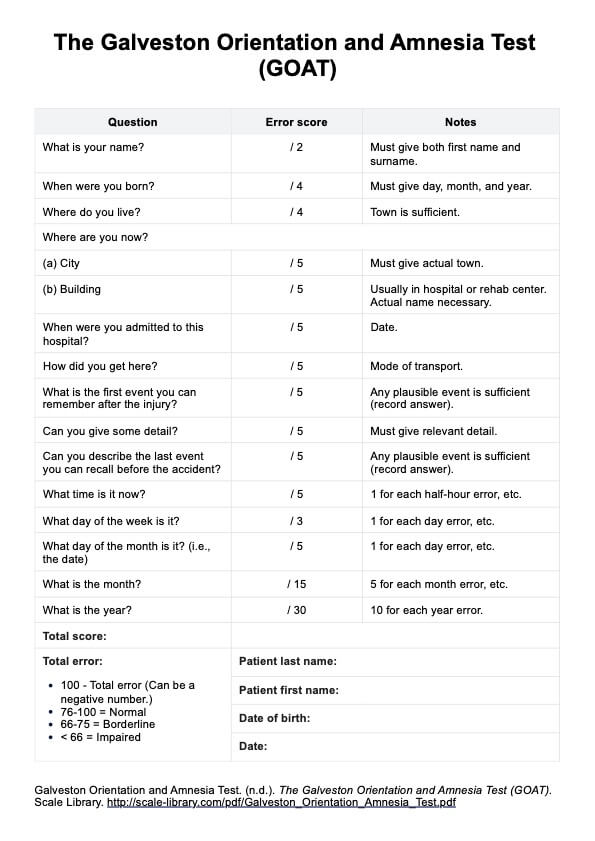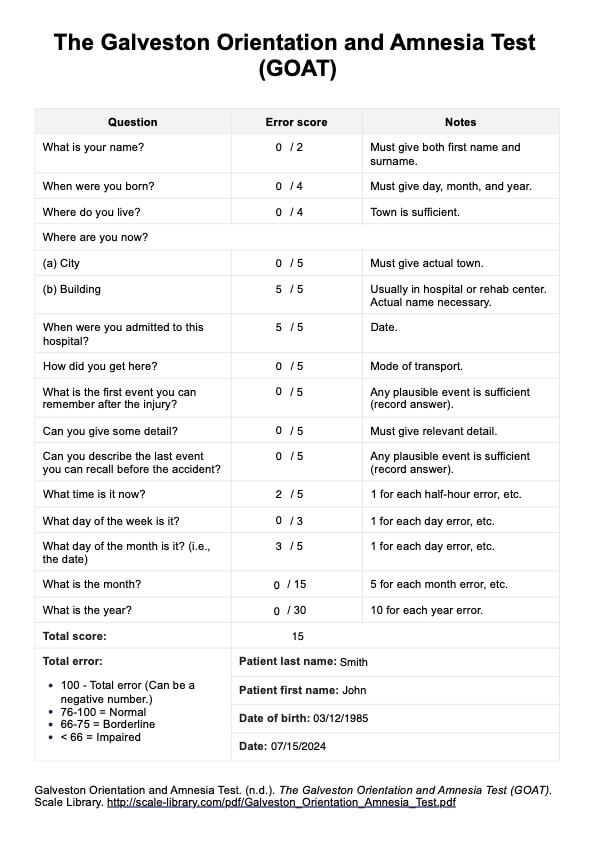Galveston Orientation and Amnesia Test (GOAT)
Learn more about the Galveston Orientation and Amnesia Test (GOAT), a critical tool in assessing post-traumatic amnesia and cognitive function following brain injury in patients.


What is a closed head injury?
A closed head injury is a type of traumatic brain injury (TBI) that occurs when an external force impacts the head without breaking the skull. This non-penetrating injury can result from falls, motor vehicle accidents, or physical assaults. Despite the skull remaining intact, closed head injuries can lead to significant brain damage and serious complications. Closed head injuries encompass several distinct categories, each with unique characteristics and implications for treatment:
- Concussion: This is a mild form of traumatic brain injury that often presents as a temporary loss of normal brain function. Individuals may experience confusion, disorientation, or even a brief loss of consciousness. Symptoms can also include headaches, dizziness, and difficulty concentrating, and while many recover fully, monitoring is crucial as repeated concussions can lead to more severe long-term effects.
- Contusion: A contusion refers to bruising of brain tissue caused by a direct impact on the head. This injury can lead to localized bleeding and swelling in the brain, potentially resulting in neurological deficits depending on the severity and location of the bruise. Recovery can vary, and medical evaluation is important to assess the extent of the injury.
- Diffuse axonal injury: This type of injury occurs when the brain undergoes rapid acceleration or deceleration, such as in car accidents or violent shaking. The rapid movement can cause widespread damage to the brain's white matter, disrupting the communication between different brain regions. Symptoms may be severe and include prolonged unconsciousness or a coma, highlighting the need for immediate medical intervention.
- Intracranial hematomas: These are serious conditions characterized by the accumulation of blood within the skull, which can create pressure on the brain. Intracranial hematomas can manifest in several forms, such as epidural hematomas (above the dura mater) and subdural hematomas (beneath the dura mater). Each type requires prompt diagnosis and treatment, often involving surgical intervention to relieve pressure and prevent further brain damage.
Understanding these categories of closed-head injuries is critical for recognizing symptoms and seeking timely medical care.
What problems can this injury cause?
Closed head injuries can cause a multitude of issues - from physical symptoms like headaches and dizziness to cognitive impairments that require health providers to assess cognition regularly. These injuries can lead to severe nervous and mental disease, necessitating comprehensive head trauma rehabilitation.
How is amnesia related to closed-head injuries?
Posttraumatic amnesia (PTA), a common consequence of closed-head injuries, involves memory loss that affects memories and the ability to form new ones. Types of amnesia include:
- Anterograde amnesia: Inability to form new memories post-injury.
- Retrograde amnesia: Loss of memories preceding the injury.
- Combined amnesia: Presence of both anterograde and retrograde amnesia.
Damage to brain regions such as the hippocampus, amygdala, and prefrontal cortex disrupts memory formation and recall processes. The duration of PTA varies based on injury severity and may last from a few minutes to several weeks or months. Longer durations often indicate more severe injuries.
Galveston Orientation and Amnesia Test (GOAT) Template
Galveston Orientation and Amnesia Test (GOAT) Example
What is the Galveston Orientation and Amnesia Test?
The Galveston Orientation and Amnesia Test (GOAT) is a brief cognitive test that evaluates cognitive function, specifically orientation to person, place, and thing, and memory, in traumatic brain injury patients. It assesses temporal and spatial orientation and biographical recall to determine the presence and duration of PTA.
How is this scored?
The GOAT consists of questions assessing the following areas:
- Temporal orientation: Awareness of date, month, and year.
- Spatial orientation: Awareness of current location.
- Biographical recall: Knowledge of personal information.
Scores range from 0 to 100, with higher scores indicating better cognitive function. A score above 78 for three consecutive days indicates recovery from PTA.
How to use our Galveston Orientation and Amnesia Test template
Our GOAT PDF template is straightforward and user-friendly, making it a valuable tool for assessing cognitive function. Here’s a detailed guide on how to effectively utilize it:
- Download the template: Begin by downloading the PDF from this page.
- Administer the test: Once you have the template, follow the instructions to ask the questions. It’s important to create a comfortable environment for the patient to encourage honest and thoughtful responses. Take your time and ensure that the patient understands each question.
- Score the responses: After the patient has answered all the questions, assign scores based on their responses. Each question evaluates different aspects of orientation and memory, so refer to the scoring rubric in the template for accuracy.
- Interpret the results: Finally, use the scoring guide to interpret the results effectively. This will help you determine the patient's cognitive function and assess the presence of post-traumatic amnesia (PTA). Discuss the findings with the patient or caregivers to provide clarity and support.
By following these steps, you can ensure a comprehensive assessment of cognitive function using our free GOAT template.
Closed head injury and amnesia treatments
Treatment for closed head injuries and associated amnesia focuses on addressing the underlying causes, managing symptoms, and facilitating recovery.
Medical interventions
Surgical options may be necessary for significant bleeding or swelling. Medication includes anti-inflammatory drugs for swelling and anticonvulsants for seizure prevention. Continuous monitoring of intracranial pressure and supportive care are also essential.
Rehabilitation approaches
Cognitive rehabilitation involves memory exercises, computer-assisted training, and compensatory strategies. Psychotherapy, particularly cognitive behavioral therapy (CBT), addresses emotional challenges. Family involvement is crucial, engaging family members in the recovery process.
Lifestyle and supportive strategies
Nutritional support aims to address deficiencies to support brain health. Mindfulness and relaxation techniques help reduce stress and anxiety. Education and awareness are important for patients and families regarding post-traumatic amnesia and recovery.
Commonly asked questions
Common symptoms include headaches, dizziness, confusion, and light sensitivity. More severe symptoms include loss of consciousness and cognitive impairments.
PTA is diagnosed through cognitive assessments like the GOAT, which evaluates orientation and memory.
Recovery time varies based on the severity of the injury, ranging from a few days to several months or longer for severe cases.
Most individuals eventually regain their memory, although some may not recall the exact moment of injury. Long-term recovery depends on injury severity and rehabilitation efforts.

.jpg)


















-template.jpg)



















































































